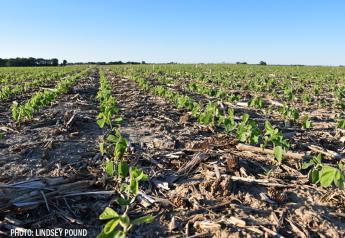Agriculture during Wartime: The Ingenuity of American Farmers During World War II

Unlike the farm policies that were implemented in the first farm bills during the 1930’s, which encouraged farmers to reduce their production levels in a number of ways in order to reduce the supply glut, that approach was turned on its head when the United States formally entered the war after the Japanese attack on Pearl Harbor in December 1941. Actually, the reversal in policy had begun somewhat quietly the previous year, as USDA opted to not impose planting restrictions on “basic commodities” that it was empowered to impose on farmers under its farm bill authority in 1940, and in the spring of 1941, the Department began to actively encourage farmers to grow more food.
Even before U.S. forces formally entered the global conflict, the U.S. government was implicitly aiding the allied governments under its “Lend-Lease” program, enacted by Congress in March of 1941. Under this legislation, the U.S. was allowed to “"sell, transfer title to, exchange, lease, lend, or otherwise dispose of, to any such government [whose defense the President deems vital to the defense of the United States] any defense article." This authority was initially deployed to provide assistance to Allied governments in Europe, and then later to China. Over its lifetime, Lend Lease enabled the U.S. government to provide about $50 billion in material aid to these countries (equivalent to $575 billion in current dollars), with the bulk going to the United Kingdom and other countries in the British Empire, the Soviet Union, France, and China, with lesser amounts to other allied countries. A large share of the initial shipments under this Act was food, as the U.S. industrial sector had not yet re-geared itself to produce large amounts of military equipment and material prior to the formal declaration of war against the Axis powers of Germany, Italy, and Japan. By the end of the war, food shipments are estimated to have accounted for about 13 percent of the total.
President Franklin Roosevelt established the War Production Board within weeks after the Pearl Harbor attack by Executive Order, with authority to regulate the wartime economy, soon replaced with the Congressionally-authorized Office of Price Administration (OPA) with authority to regulate prices and ration the supply of certain strategic goods. Those ‘strategic goods’ included certain staple foods, such as meat, coffee, dairy products, sugar, dried fruit, jams and jellies, and lard and liquid vegetable oil. On the non-food side, the list included automobiles, tires, gasoline, fuel oil, coal, firewood, nylon, silk, and shoes
The rationing of tires and gasoline affected farmers adversely, as did the shortage of tractors, as many of the companies making such implements shifted over to making military goods. With authority delegated by the OPA, Agriculture Secretary Claude Wickard imposed a rationing requirement on all types of farm equipment in September 1942, which remained in place more than two years. This constraint probably slowed the adoption of tractors by farmers, which nonetheless increased from 25 percent in 1940 to more than 40 percent in 1945.
The other major obstacle to farmers increasing their output in response to wartime demand was the shortage of farmworkers. It is estimated that about 16 million Americans served in the armed forces during the course of World War II, including hundreds of thousands who had previously worked as either farmers or farmworkers. Farmers were forced to draw on additional pools of labor in order to fill the gap. These groups included Mexican immigrants under the so-called bracero program, women hired farmworkers, and most unusually, prisoners of war from Axis countries held in camps around the United States.
In 1942, the Roosevelt administration negotiated an arrangement with the government of Mexico to allow Mexican citizens to be brought into the country to work in agriculture and ag-related industries This program, known as the Bracero program (from the Spanish phrase for “one who works with his arms”) was launched in August 1942 and continued in various forms until 1964. About 50,000 Mexicans entered annually under this program during the course of the war.
American women joined the farm workforce in greater numbers during the war, as was the case in manufacturing workers represented by the iconic “Rosie the Riveter” image promoted by the federal government to encourage women to take such positions. Although the Women’s Land Army operated as a non-profit organization without government funds during World War I, the U.S. Department of Agriculture did formally organize such a group starting in 1943, recruiting as many as 600,000 women across the country, although farmers in some Midwest states rejected the notion of having such workers in their operations.
Early in the war, the U.S. government agreed to take custody of a large number of German prisoners captured by British forces during their campaign in North Africa because the British government was having difficulty feeding and housing them properly. Ultimately, about 425,000 prisoners from Axis countries, primarily Germany, were re-located to the continental United States, housed in about 500 camps spread across the country. In some states, farmers made deals with the local camp commanders to hire prisoners to come work on their operations. Under the terms of the Geneva Convention, prisoners could not be forced to work outside their camps, and were paid for their labor. Part of their pay went to cover the cost of operating the camps, but they were also given scrip to purchase items in camp stores. When they were repatriated to Europe after the war ended, many of them also took hundreds of dollars from their camp accounts with them, helping to bolster the German economy. It is estimated that about 5,000 of the former German POW’s chose to emigrate to the United States.
Despite the obstacles they faced, American farmers were able to expand their crop acreage during the war, increasing harvested acres of corn, wheat, and oats by 9 percent, 15 percent, and 22 percent respectively between 1940 and 1945, according to data collected under the Census of Agriculture. The value of U.S. agricultural exports climbed sharply during the course of the war, starting with a 30 percent increase from $517 million in 1940 to $669 million in 1941, then leaping to nearly $3.2 billion by 1946, a year after the war ended but before the food exports associated with the Marshall Plan kicked in starting in 1948.







